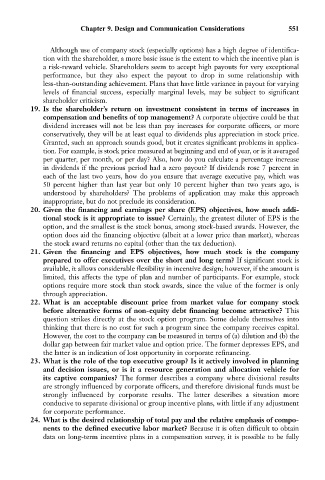Page 565 - Bruce Ellig - The Complete Guide to Executive Compensation (2007)
P. 565
Chapter 9. Design and Communication Considerations 551
Although use of company stock (especially options) has a high degree of identifica-
tion with the shareholder, a more basic issue is the extent to which the incentive plan is
a risk-reward vehicle. Shareholders seem to accept high payouts for very exceptional
performance, but they also expect the payout to drop in some relationship with
less-than-outstanding achievement. Plans that have little variance in payout for varying
levels of financial success, especially marginal levels, may be subject to significant
shareholder criticism.
19. Is the shareholder’s return on investment consistent in terms of increases in
compensation and benefits of top management? A corporate objective could be that
dividend increases will not be less than pay increases for corporate officers, or more
conservatively, they will be at least equal to dividends plus appreciation in stock price.
Granted, such an approach sounds good, but it creates significant problems in applica-
tion. For example, is stock price measured at beginning and end of year, or is it averaged
per quarter, per month, or per day? Also, how do you calculate a percentage increase
in dividends if the previous period had a zero payout? If dividends rose 7 percent in
each of the last two years, how do you ensure that average executive pay, which was
50 percent higher than last year but only 10 percent higher than two years ago, is
understood by shareholders? The problems of application may make this approach
inappropriate, but do not preclude its consideration.
20. Given the financing and earnings per share (EPS) objectives, how much addi-
tional stock is it appropriate to issue? Certainly, the greatest diluter of EPS is the
option, and the smallest is the stock bonus, among stock-based awards. However, the
option does aid the financing objective (albeit at a lower price than market), whereas
the stock award returns no capital (other than the tax deduction).
21. Given the financing and EPS objectives, how much stock is the company
prepared to offer executives over the short and long term? If significant stock is
available, it allows considerable flexibility in incentive design; however, if the amount is
limited, this affects the type of plan and number of participants. For example, stock
options require more stock than stock awards, since the value of the former is only
through appreciation.
22. What is an acceptable discount price from market value for company stock
before alternative forms of non-equity debt financing become attractive? This
question strikes directly at the stock option program. Some delude themselves into
thinking that there is no cost for such a program since the company receives capital.
However, the cost to the company can be measured in terms of (a) dilution and (b) the
dollar gap between fair market value and option price. The former depresses EPS, and
the latter is an indication of lost opportunity in corporate refinancing.
23. What is the role of the top executive group? Is it actively involved in planning
and decision issues, or is it a resource generation and allocation vehicle for
its captive companies? The former describes a company where divisional results
are strongly influenced by corporate officers, and therefore divisional funds must be
strongly influenced by corporate results. The latter describes a situation more
conducive to separate divisional or group incentive plans, with little if any adjustment
for corporate performance.
24. What is the desired relationship of total pay and the relative emphasis of compo-
nents to the defined executive labor market? Because it is often difficult to obtain
data on long-term incentive plans in a compensation survey, it is possible to be fully

